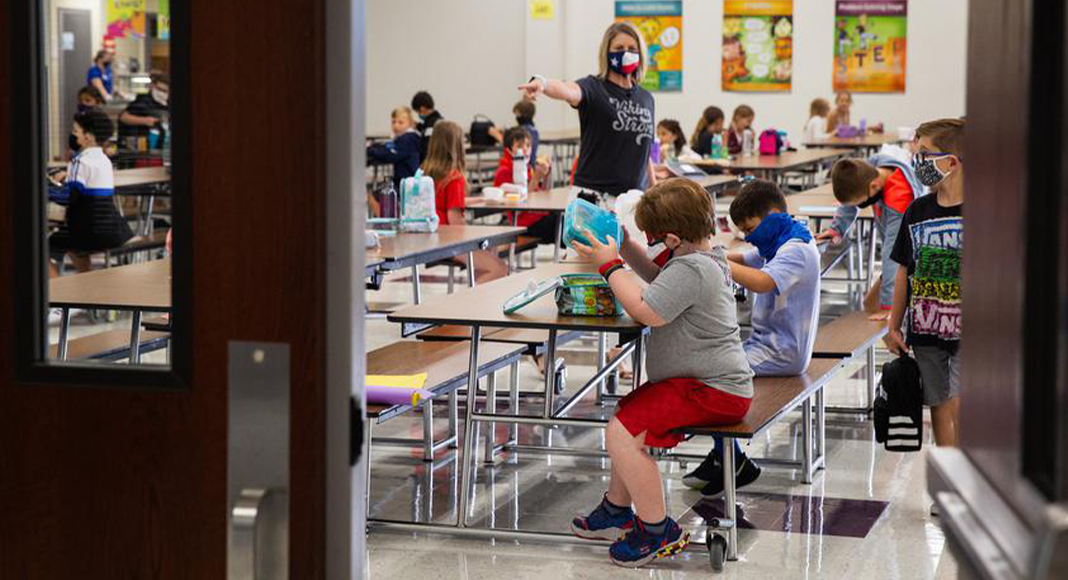
Texas Border Business
BY DUNCAN AGNEW
Need to stay updated on coronavirus news in Texas? Our evening roundup will help you stay on top of the day’s latest updates. Sign up here.
Texas families receiving pandemic-era federal food assistance for students who qualify for free or reduced-price school meals will soon see a 15% increase in their benefits. That additional aid is one of three food access issues President Joe Biden addressed in an executive order last week.
The moves come as 16.5% of the state’s 29 million residents said they did not always have enough food to eat in the last seven days, according to the U.S. Census Bureau’s Household Pulse Survey.
The U.S. Department of Agriculture last year approved the Pandemic Electronic Benefits Transfer Emergency School Meals Program, which sends money directly to families to make up for missed school meals due to virtual learning. That benefit will increase from $5.86 to $6.74 per child per school day. In the spring, nearly 3 million households in Texas received meal funding due to school closures.
It’s not clear yet when Texas families will begin receiving the increases, but a Texas Health and Human Services Commission spokesperson said that the department is working with the Texas Education Agency and the Texas Department of Agriculture on a plan.
“Once the plan is submitted and approved by USDA [Food and Nutrition Service], these collaborative efforts will ensure that eligible children receive these benefits in an efficient manner,” the spokesperson told the Tribune.
HHSC expects to have an update on the status of benefits distribution at some point “in the next few weeks,” according to the spokesperson.
Additionally, Biden last week ordered the U.S. Department of Agriculture to investigate whether it can allow states to increase Supplemental Nutrition Assistance Program payments, commonly known as food stamps.
Any expansion of those benefits could take a while to reach people’s pockets, though, as the USDA first has to determine whether it has the authority to increase payments without congressional approval. If that attempt fails, Congress can still vote on a measure to approve an expansion of SNAP benefits, but it remains unclear how long Americans will have to wait for extra aid.
“One of the most positive signs, obviously, from this executive order is that it signals President Biden’s commitment to addressing pandemic-related hunger,” said Celia Cole, CEO of Feeding Texas, a hunger-relief organization. “It’s acknowledging the fact that the pandemic has caused food insecurity to spike in this country, and that there’s really not an immediate end in sight.”
According to HHSC data, Texans filed 197,378 applications for SNAP benefits in December. That was down from 243,157 applications in November, but up from 144,803 applications in December 2019. Over 1.5 million individuals in the state, making up over 5% of all Texans, received food relief last month. The most recent HHSC report estimated that nearly 13% of the state’s residents — or 3.7 million people — are eligible for SNAP benefits.
During the pandemic, Texas has seen food insecurity rates more than double, according to Cole. Current U.S. census data estimates that 13.7% of adult Americans either sometimes or often did not have enough to eat in the last seven days. Out of all 50 states, Texas registered the fourth highest rate of food scarcity in the last week.
Meanwhile, President Biden also directed the USDA to revise the Thrifty Food Plan, which establishes food costs and serves as the basis for SNAP payments. The plan was last updated in 2006, and critics say that it no longer provides a realistic pricing model for a healthy and nutritious diet. Modernizing that protocol would lead to more benefits for SNAP-eligible households, according to Cole.
SNAP benefits typically decrease as an individual’s income increases. But Congress last year allowed all eligible applicants to receive the full benefit for a given household size. However, a staggering 40% of all SNAP recipients nationwide already qualified for the maximum benefit. So that food-relief effort earlier in the pandemic did little to solve the problems of the most vulnerable people.
“It didn’t do anything back in the spring to help those folks who were already getting the maximum,” Cole said. “And because they were already getting the maximum, we know that they are the poorest families, and so this is really about making sure that the SNAP program is doing the most it can to help the poorest families getting those benefits.”
Biden’s executive order also asked the USDA to work with the Department of Justice on possible solutions that would allow for additional funding for the lowest income SNAP recipients. If the DOJ determines that the USDA has the legal authority to allow states to expand their SNAP payments to the most impoverished households, Cole hopes Gov. Greg Abbott will take advantage of that opportunity immediately.
A spokesperson for Abbott did not immediately respond to a request for comment Tuesday.
Texans filed more than 4 million unemployment claims last year. For months, the state’s unemployment rate has been near or above where it was during the worst of the Great Recession.













